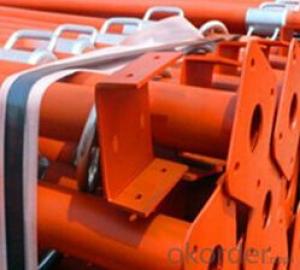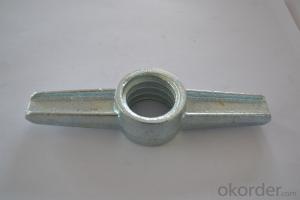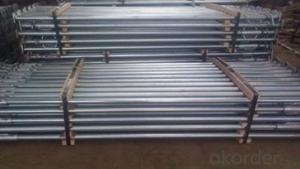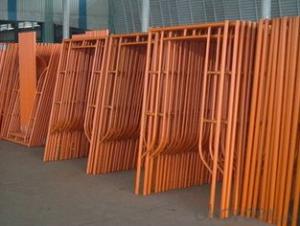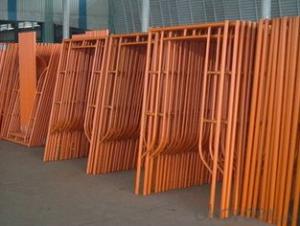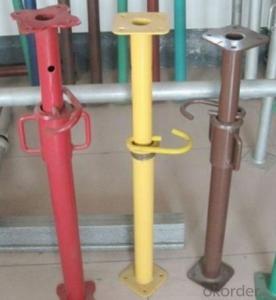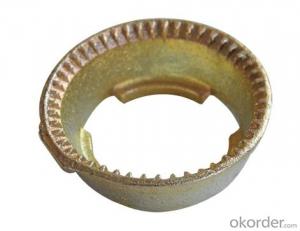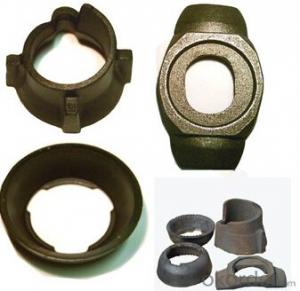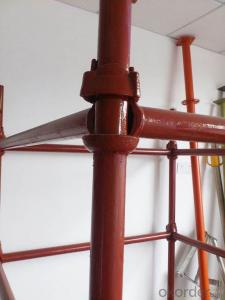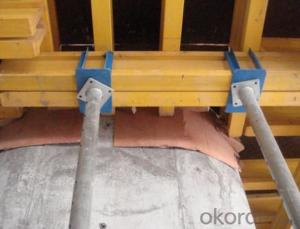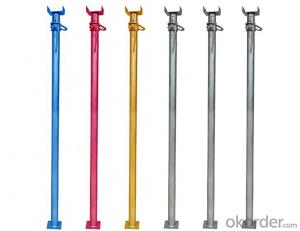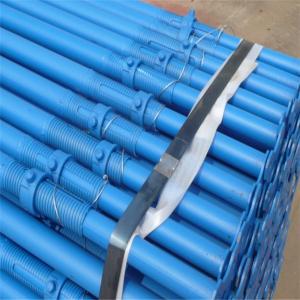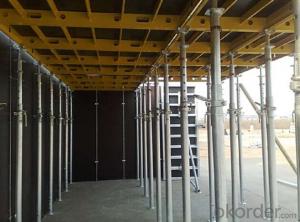scaffolding Bottom cup, top cup, leger blade for cup-lock
- Loading Port:
- Tianjin
- Payment Terms:
- TT OR LC
- Min Order Qty:
- 10000 PCS
- Supply Capability:
- 10000 PCS/month
OKorder Service Pledge
Quality Product, Order Online Tracking, Timely Delivery
OKorder Financial Service
Credit Rating, Credit Services, Credit Purchasing
You Might Also Like
Quick Details
| Type: | Scaffolding Parts | Scaffolding Part Type: | Scaffolding Props | material: | Q235 welded pipe |
| types: | heavy duty prop, light duty prop | color: | silver,orange, blue, dark red, etc, as client's request | surface treatment: | galvanized, powder coated, prainted |
| certification: | ISO9001:2008,SGS,BV | application: | civil contruction |
| Type: | Scaffolding Parts | Scaffolding Part Type: | Scaffolding Props | material: | Q235 welded pipe |
| types: | heavy duty prop, light duty prop | color: | silver,orange, blue, dark red, etc, as client's request | surface treatment: | galvanized, powder coated, prainted |
| certification: | ISO9001:2008,SGS,BV | application: | civil contruction |
HEAVY DUTY PROP
LIGHT DUTY PROP
- Q: Can steel props be used in commercial building construction?
- Commercial building construction can utilize steel props for support. These props, also known as adjustable steel props or steel acrow props, are commonly used in construction projects to stabilize temporary structures. They are typically employed to provide temporary support for beams, slabs, walls, and ceilings during construction or renovation work. Steel props possess great versatility and can be adjusted to different heights, making them suitable for commercial building construction where varying height requirements may arise. They are constructed from high-quality steel, ensuring strength and durability, and are capable of withstanding heavy loads. In commercial building construction, steel props are often used alongside other support systems, such as scaffolding, to enhance stability and safety. They are easily installed and adjusted to the desired height, delivering a reliable and secure temporary support system. Furthermore, steel props are specifically designed to meet industry safety standards and regulations, guaranteeing their safe application in commercial building construction. They undergo rigorous testing and quality control measures to ensure reliability and performance. All in all, steel props are a favored choice in commercial building construction due to their strength, adjustability, and versatility. They provide temporary support and stability, facilitating efficient and safe construction processes.
- Q: Are steel props suitable for use in high-voltage transmission line construction?
- Steel props are not suitable for use in high-voltage transmission line construction. These props are typically used in construction activities to provide temporary support to structures. However, in the case of high-voltage transmission line construction, there are several reasons why steel props are not suitable. Firstly, high-voltage transmission lines carry extremely high electrical currents. Steel is a good conductor of electricity, which means that using steel props near these lines can increase the risk of electrical accidents. If the props come into contact with the transmission lines, it can result in electricity conducting through them, posing a significant danger to workers and potentially causing equipment damage. Secondly, steel props may not have the necessary insulation properties required for high-voltage environments. High-voltage transmission lines often operate at voltages ranging from 69,000 volts to over 500,000 volts. It is crucial to ensure that any equipment used in their construction is properly insulated to prevent electrical discharge or arcing between the props and the transmission lines. Additionally, steel props may not have the structural strength and stability required for high-voltage transmission line construction. These lines often span over long distances and are subjected to various environmental factors such as wind, ice, and temperature changes. The props used in their construction need to be able to withstand these forces and maintain their stability, which may not be guaranteed with steel props. Instead, specialized equipment and tools designed specifically for high-voltage transmission line construction are used. These include insulated aerial lifts, conductive ropes, and other safety gear that are engineered to meet the unique requirements and safety standards of working near high-voltage infrastructure. In conclusion, steel props are not suitable for use in high-voltage transmission line construction due to their conductive nature, lack of insulation properties, and potential structural limitations. It is crucial to prioritize safety and use specialized equipment that is specifically designed for working in high-voltage environments to minimize risks and ensure the successful completion of these projects.
- Q: Are steel props adjustable?
- Yes, steel props are adjustable. Steel props, also known as adjustable steel props or steel acrow props, are commonly used in construction and temporary support applications. They are designed to provide temporary support to beams, walls, or ceilings during construction or renovation projects. Steel props are usually made up of two main components: an outer tube and an inner tube. The outer tube is typically made of high-quality steel and has several holes along its length, while the inner tube can slide inside the outer tube and is used to adjust the height of the prop. To adjust the prop, you simply need to unlock the prop's collar and slide the inner tube up or down to the desired height. Once you've set the desired height, you lock the collar again to secure the prop in place. This adjustability feature allows steel props to be easily adjusted to different heights, making them versatile and flexible for various construction needs. Steel props are known for their strength, stability, and load-bearing capacity. They are commonly used in applications such as supporting formwork, scaffolding, or temporary structures. The adjustable nature of steel props allows for easy installation and removal, as well as the ability to adapt to different project requirements. Overall, steel props are a reliable and adjustable solution for temporary support needs in construction projects, providing stability and safety during the construction process.
- Q: Can steel props be used to support heavy machinery?
- Yes, steel props can be used to support heavy machinery. Steel props are sturdy and durable, making them suitable for providing strong support to heavy loads.
- Q: Are steel props subject to any industry standards or regulations?
- Yes, steel props used in construction are subject to industry standards and regulations. These standards ensure that the props meet specific safety requirements and performance criteria, ensuring the structural integrity and stability of temporary support systems in various building projects. Compliance with these standards is crucial to ensure the safety of workers and the successful completion of construction projects.
- Q: Can steel props be used to support roof structures?
- Yes, steel props can be used to support roof structures. Steel props, also known as adjustable steel props or scaffolding props, are commonly used in construction and renovation projects to support various structures, including roof structures. These props are adjustable in height, allowing them to be set at the desired level to provide support to the roof during construction or repair work. Steel props are typically made from high-quality steel, making them strong and capable of withstanding heavy loads. They are also easy to install and dismantle, making them a convenient and reliable choice for providing temporary support to roof structures. Overall, steel props are a popular and effective solution for supporting roof structures in construction projects.
- Q: How do you check the stability of a steel prop?
- To check the stability of a steel prop, several steps can be taken. Firstly, visually inspect the prop for any visible signs of damage such as cracks or bent components. Secondly, ensure that the prop is positioned on a solid and level surface, free from any obstructions or loose objects. Thirdly, verify that all locking mechanisms, pins, and adjustments are securely in place. Finally, apply gentle pressure or load onto the prop to assess its stability and make sure it can withstand the intended load without any wobbling or shifting.
- Q: Can steel props be used in concrete slab construction?
- Steel props are indeed applicable in concrete slab construction. These props, alternatively referred to as adjustable steel props or steel shoring props, are frequently employed to uphold temporary structures like formwork while pouring and curing concrete slabs. Their primary function is to bestow stability and fortitude upon the formwork, guaranteeing that the concrete slab remains intact and evades collapse or distortion throughout the construction process. By virtue of their adjustable nature, these props can be modified in height to accommodate varying slab thicknesses and support diverse load requirements. Moreover, they are conveniently installed, dismantled, and repositioned, rendering them a favored choice in projects involving concrete slab construction.
- Q: How do steel props accommodate for changes in load during construction?
- Steel props, commonly used in construction projects, are versatile and adjustable support systems that provide temporary support to structures. These props are designed to easily modify their height and load-bearing capacity, allowing them to accommodate changes in load during construction. One way steel props handle changes in load is through their telescopic design. Composed of an inner tube that can be extended or retracted and an outer tube that provides additional support, these props can be easily adjusted to support different loads or compensate for changes in the structure's weight distribution by altering the height of the inner tube. Moreover, steel props often feature adjustable load-bearing heads. Contractors can rotate or tilt these heads to ensure even distribution and proper support of the load. By manipulating the position and orientation of the load-bearing head, contractors can effectively distribute the weight, preventing overloading on specific areas and ensuring structural stability. Furthermore, steel props are typically rated for specific load capacities and engineered to withstand various loads. This allows for the selection of props based on the anticipated load requirements of the construction project. If the load changes during construction, props with higher load capacities can be easily substituted to ensure the structure remains adequately supported. In summary, steel props offer flexibility and adaptability to accommodate changes in load during construction. Through their telescopic design, adjustable load-bearing heads, and available load capacities, they provide a reliable and efficient solution for supporting structures under varying load conditions.
- Q: Do steel props have any height indicators for easy adjustment?
- Yes, steel props commonly have height indicators marked on their outer surface, allowing for easy adjustment and precise positioning according to required heights.
Send your message to us
scaffolding Bottom cup, top cup, leger blade for cup-lock
- Loading Port:
- Tianjin
- Payment Terms:
- TT OR LC
- Min Order Qty:
- 10000 PCS
- Supply Capability:
- 10000 PCS/month
OKorder Service Pledge
Quality Product, Order Online Tracking, Timely Delivery
OKorder Financial Service
Credit Rating, Credit Services, Credit Purchasing
Similar products
Hot products
Hot Searches
